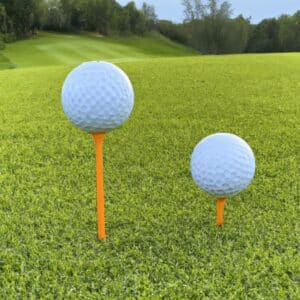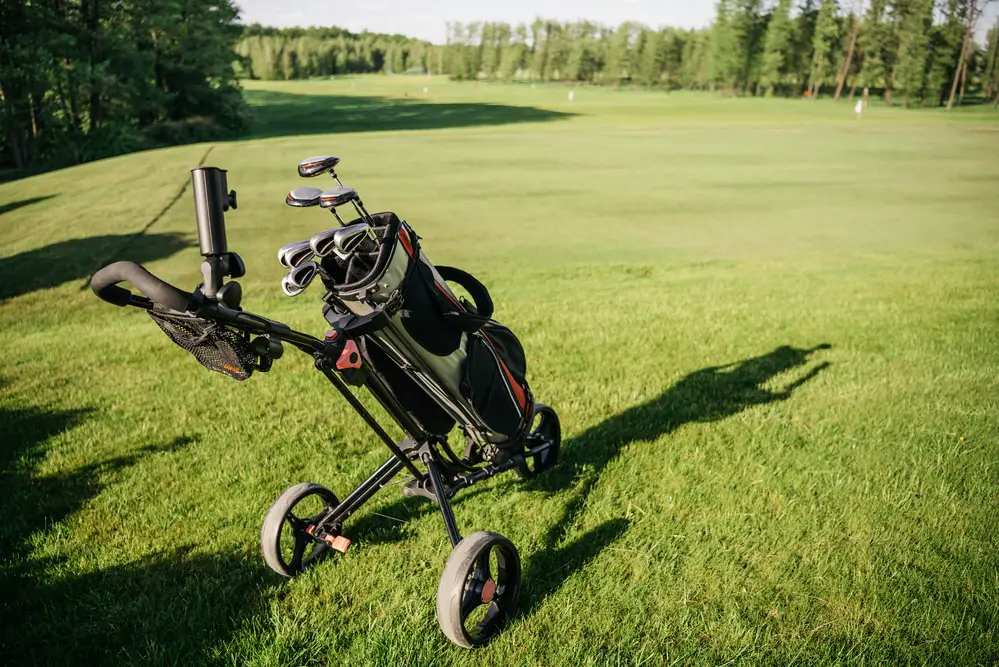Last Updated on June 6, 2023
If you’ve ever wondered what type of golf tees to use, then this article is for you! Whether you’re a beginner or an expert golfer, choosing the right tee can make all the difference on the course. This guide will walk you through everything you need to know about selecting and using the right golf tee.
Golfers have plenty of choices when it comes to picking out a golf tee – wooden, plastic, rubber…the list goes on. However, while there are many options available, knowing which one best suits your needs isn’t always easy. You’ll want to consider factors like price point, durability, and performance before making your final decision.
The good news? With just a few tips from experienced golfers, finding the perfect tee doesn’t have to be complicated. Keep reading for more information about which golf tees should work best for your game!
Overview Of Golf Tees
Golf tees are an integral part of the game, acting as a support for the golf ball when teeing off. They come in various types and sizes, with each offering its own unique advantages. Tee construction and design can vary greatly depending on the type of golf club being used. There are also different lengths available to suit all players’ preferences.

Tee types include wooden tees, plastic tees, fibreglass tees, rubber tees and metal tees. Wooden tees provide excellent durability but may break after multiple uses. Plastic tees offer more flexibility than wood but lack stability at impact; however, they are inexpensive and widely available. Fibreglass is lightweight yet strong, making it ideal for long drives while providing less resistance at impact compared to other materials. Rubber tees have good shock absorption properties, which help reduce vibration during contact with the ball, while metal tees have superior strength and resilience that make them suitable for heavier clubs such as drivers or fairway woods. The length of the tee should be chosen based on individual preference; shorter lengths will require fewer strokes to reach the green, while longer ones allow you to hit further with greater accuracy.
No matter what your style or skill level, there’s sure to be a golf tee that suits your needs perfectly!
Benefits Of Different Materials
The golf tee you choose can have an effect on your game. There are a variety of materials to consider, each with its own benefits and drawbacks:
- Plastic tees: These are the most common type of tees used by amateur players. They’re inexpensive, lightweight, and sturdier than wooden ones; plus, they come in a range of colours. However, their durability may be compromised when faced with high impact shots at the driving range or course.
- Wooden tees: Wooden tees provide the traditional look that many golfers prefer while playing. They’re quite durable but tend to break more easily than plastic ones if used for repeated drives from the same spot.
- Composite tees: These blend both wood and plastic components into one tee, thus combining features of both material types. As such, composite tees offer greater strength and rigidity over either wood or plastic alone, making them great for long-drive tournaments or practice sessions where numerous drives must be made from the same spot without changing out your tee every time.
- Graphite tees: These are among the newest materials available for use as golf tees. Their composition is lightweight yet strong enough to withstand multiple impacts without breaking down like some other materials would do after only a few uses. Additionally, graphite offers superior stability compared to other materials, so it’s ideal for those who need maximum accuracy during their round of golf.
- Rubber Tees: The softness of rubber makes these particularly useful on courses with concrete fairways as they reduce vibration upon contact, helping preserve club head speed throughout swings—especially off drivers! Plus, they’re extremely durable, so they don’t need replacing all too often despite constant use on tough surfaces.
No matter which material you eventually decide to go with, always try different types to determine what works best for you, depending on your skill level and preferences during play!
Variations In Lengths
Golf tees come in a variety of lengths to accommodate different golfers and clubs. There are three main categories for tee length choices: short, standard, and long. Short tees measure approximately 1 3/4 inches tall; standard tees measure around 2 3/4 inches tall, and long tees stand about 4 inches high. To determine the best fitting tee length for your game, compare these measurements with your club head size.
| Length Measurement | Tee Type | Height (in) |
|---|---|---|
| Short | 1 3/4 | |
| Standard | 2 3/4 | |
| Long | 4 |

The table above provides visual comparisons of each tee length measurement. Make sure that you select the right type based on the height of your club head compared to the range of heights provided by the manufacturer for their various types of golf tees. If you choose a tee that is too short or too long, it can affect how well you hit the ball off the tee box as well as its trajectory when it leaves the ground. Additionally, if you use an overly long tee, it could create unnecessary drag on your swing, which may cause mis-hits during play. Remember that experimenting with different lengths can help you find the one that fits perfectly with your equipment and playing style!
Considerations For Head Size
When choosing golf tees, head size is an important factor to consider. The size of the tee’s head affects how easily and evenly the ball will sit on it. There are a few factors that can influence your choice of tee head size.
The first consideration should be whether you prefer distance or accuracy when driving the ball off the tee. If you’re looking for more distance, then a larger head size may suit your needs better than a smaller one, as it provides less resistance against the clubface at impact. On the other hand, if accuracy is more important, then a smaller head size could provide better control over where the ball goes due to its increased drag coefficient, providing more friction during contact with the clubface.
Another key factor in selecting a tee head size is what type of driver you use. Drivers with higher loft angles require shorter tees, whereas drivers with lower loft angles need longer ones in order to allow for optimal launch angle and spin rate upon contact with the golf ball. Comparing different sizes and heights of tees can help you determine which works best with your particular setup. Understanding these considerations can ensure that you choose the right golf tee for maximum performance while out on the course.
How To Test Tee Performance
Testing the performance of golf tees is an essential part of choosing which tee to use for your game. While there are many different types and sizes available, testing each one can help determine which will work best for you. Tee performance testing involves evaluating how well the tee holds up under various conditions, such as contact with a golf ball, ground impact, weather exposure and more.

To test a tee’s performance, start by inspecting it for any signs of wear or damage. Look at the surface texture as well as overall shape; if either has been compromised in any way, then this could affect its ability to hold onto a ball correctly. You should also check out how much force is required to insert it into the ground – too little and it may not stay put during swings, while too much pressure might cause it to break easily when hit. Lastly, consider whether or not the material used is suitable for all kinds of weather conditions – some materials may be better suited for hot climates while others may perform better in cold temperatures.
Frequently Asked Questions
How Often Should I Replace My Golf Tees?
Replacing golf tees is an important part of playing the game. Knowing when to replace your tee can help you get more out of your round, as well as save time and money. Understanding the frequency of replacing golf tees and the different tips that come with them are essential if you want to consistently have good results on the course.
When choosing a replacement tee, there are several factors that should be taken into consideration, such as its lifespan, durability, suitability for your club head speed and angle, and overall cost-effectiveness. When considering these elements, deciding how often to replace your tee becomes easier. Generally speaking, a quality tee will last between 10-15 rounds before needing to be replaced; this depends largely upon how hard you hit the ball off the tee box. If you’re hitting with greater force than normal or frequently striking tree roots or other objects while making contact with the ball, then you may need to consider replacing them sooner than expected. Additionally, cheaper plastic tees tend to break down much faster than their wooden counterparts, so they’ll require replacing more regularly in most cases.
How Do I Know Which Type Of Golf Tee Is Best For Me?
One way to determine which type of golf tee is best suited for you is by considering your swing speed and ball trajectory. If you have a slower swing, then using shorter tees may be more beneficial as they will allow for better contact with the ball. On the other hand, if you’re playing with faster clubs, then taller tees might be preferred in order to provide extra height and lift off from the ground. Additionally, picking between plastic or wooden tees can also influence accuracy – depending on whether you need a softer feel when making contact with the ball or something that offers greater durability over time.
Conclusion
Choosing the right golf tee can make all the difference in your game. Ultimately, choosing the appropriate golf tee comes down to trial and error as well as personal preference. It’s important to experiment with different types of tees in order to find out which one works best for you. With some time and patience, you’ll soon have an arsenal of quality golf tees at your disposal!



